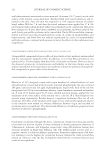STABILITY OF A CREAM CONTAINING LECYTHIS PISONIS EXTRACT 159 This instability in formulations with the extract is noticeable in the high concentration formula. It may have occurred due to the high concentration of the extract, associated with a higher tannin content. These molecules are astringent and could affect the emulsi- fi er’s action, creating a separation of phases (22,26,27). This kind of incompatibility of plant extract in a cream formula was reported in the literature (25). It could be adjusted by making a correction in the amount of extract or changing the emulsifi er used. All information concerning the organol eptic characteristics before and after the stability test are described in Table I. Regarding color, all samples tested did not present any varia- tion. Concerning odor, as the stability cycles were in progress, a more present smell of nuts was noticed for the samples with extract and wax smell in sample S0. As noticed before the stability test, in all samples with the extract, a separation of phases was visible and less evident in samples S0.5 and S1. These results indicate that a formula adjustment is re- quired to improve the stability, being an option will be the amount of surfactant added. Normally, the skin’s pH is more acid t han the rest of the body, between 4 and 6, to act as protection against microorganisms and maintain the stratum corneum integrity (28). Human skin is different between ethnicities. More pigmented or afro-descendant people usually have a more acid surface than Caucasian people, so it is possible to observe a more integrated and functional defense barrier (29). These factors will enhance the lipidic con- tent and lamellar density, and lower the pH in pigmented people (28). Also, besides, the basal value of pH may vary according to the different parts of the body (30). The mature skins tend to have an elevated pH than younger people (28). The maintenance of acid pH inhibits the unbalance in the stratum corneum’s defense barrier, as unviable the action of certain alkaline enzymes, and favors the activity of enzymes involved with ceramides formation (28,30). So, the use of products that help maintain an acid pH will benefi t skin integrity maintenance. Several studies indicate polyhydroxyla ted acids in topic products to enhance skin barrier in newborn and elderly mice (29). The pH of the formulations containing the extract did not change during the stability test, neither did the base formula (S0). The acid pH in the formulation may contribute to Table I Physical–Chemical and Organoleptic Characteristics o f a Cream Containing L. pisonis Extract before and after the Stability Test Characteristics Separation of phases Texture Odor Color pH (potentiometric) Spreadability (cm2) B A B A B A B A B A B A S0 S S S S S S S S 2.96a 2.84a 18.338 ± 0.080 10.65 ± 0.058 S0.5 NS NS NS NS S S S S 3.00a 2.83a 20.686 ± 0.101 11.94 ± 0.075 S1.0 NS NS NS NS S S S S 2.98a 2.85a 32.996 ± 0.101 14.068 ± 0.063 S5.0 NS NS NS NS S S S S 3.08a 2.90a 30.992 ± 0.138 10.844 ± 0.227 C — — — — — — — — — — 32.321 ± 0.101 — S0: base cream without extract S0.5: cream containing 0.5% of L. pisonis extract S1.0: cream containing 1% of L. pisonis extract S5.0: cream containing 5% of L. pisonis extract C: commercial product B: before stabil- ity test A: after stability test S: stable NS: nonstable.
JOURNAL OF COSMETIC SCIENCE 160 the skin’s maintenance, reducing sensibility, increasing the keratinocyte ceramide pro- duction (29), and contributing to reducing stratum corneum degradation. Therefore, considering that the L. pis onis extract is rich in tannins derived from gallic acid (unpublished results), it could mimic the polyhydroxylated acids and benefi t the skin. However, more studies are required to elucidate the action. About the spreadability, it is p ossible to observe that previously to the stability test, it increased as higher as the concentration of the extract for samples S0.5 and S1.0 however, in sample S5.0, the spreadability was lower than observed for sample S1.0. Moreover, the S1.0 spreadability was the closest to the control sample. After the stability test, no al- terations were observed, continuing sample S1.0 with the better spreadability between the extract samples. The spreadability, determined as the e xpansion of the semi-solid formula over a surface after a certain period (16), is a relevant factor in a cosmetic product because it is related to how easily the product will spread in the skin, whether it is healthy or not, reducing the quantity necessary per region, and guaranteeing the effect, making it pleasant to cos- tumer (31). Figure 1. Samples of the formulations tested (left to right ) : S0 (base formulation), S0.5 (formulation with 0.5% of L. pisonis extract), S1.0 (formulation with 1% of L. pisonis extract), and S5.0 (formulation with 5% of L. pisonis extract).
Purchased for the exclusive use of nofirst nolast (unknown) From: SCC Media Library & Resource Center (library.scconline.org)

























































































































